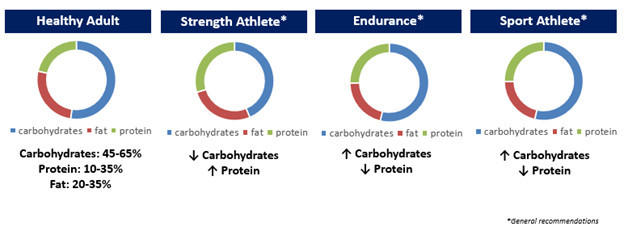Macronutrients, often simply called “macros,” include carbohydrates, protein, and fat – each playing a critical role in the body. They also provide the calories your body needs to function. Your body can metabolize or break down all three macronutrients to release energy. Therefore, it’s important to have the right balance of nutrients within your diet.
With that in mind, macro tracking, or macro counting, can help you reach any number of fitness goals like muscle gain, weight loss, endurance, and more.
Below, we’ll go into detail about the right balance of macros for your unique needs, how you can track macros, the tools you can use to do so (like a tracking app for mobile), and how to stay on track with your macro goals.
What’s the right balance?
It really depends on what you're trying to accomplish.
The acceptable macronutrient distribution range (AMDR) is the number of total calories from each macronutrient recommended in a day. For a healthy adult, it breaks down as follows:
- Carbohydrates: 45-65%
- Protein: 10-35%
- Fat: 20-35%
But again, you may have specialized goals. For instance, strength athletes may increase protein to support muscle recovery while lowering carbohydrates. However, carbohydrates are still a required nutrient that helps support overall energy by fueling working muscles, refueling muscle, and supplying energy for muscle recovery and development. As for fats, they play a role in nutrient absorption, hormone production, and other vital functions. The important thing to remember is that whether you’re a physique athlete, endurance athlete, or team sport athlete, you want to stay within the AMDR and balance all three macronutrients within your diet.
Step 1: Determine your goal
Knowing your goal can influence the distribution of macronutrients.
Step 2: Calculate Your Needs
First, you’ll want to determine your caloric needs. Next, you’ll want to calculate your macronutrient needs. Note that you will need to re-calculate your needs if your weight changes, activity level changes, and/or if you need to adjust your performance goals.
Step 3: Measure Macros
Different foods provide different calories, but there is only one standard by which we measure macronutrients. Carbohydrates and protein provide 4 calories per gram. Fat provides 9 calories per gram. You can track your macros by using journals and/or a tracking app on your mobile device. You can measure your food portions by using a food scale and/or measuring cups to ensure accuracy. Over time, you’ll develop a sense for portion sizes.
Step 4: Continually Review Progress
As you move forward, keep in mind that these are starting points, and you will need to continually review your progress as you move forward with your personal performance goals. Over time, you should be able to assess and adjust without logging your overall macro intake.
Understanding your nutritional needs is one of the first steps to help you achieve your performance goals. Start with a goal that is specific, attainable, and measurable. Continually review your progress as you move forward with your personal performance. Tracking macro intake in detail is a great way to get started, but it may not be necessary in the long-term. Over time, you should be able to get a sense for your macro intake and adjust without the use of a dietary log or tracking app. Remember, tracking your macros is just one tool to help manage your nutrition. The goal of any diet is to ensure balance, variety, and moderation.
Macro Supplements
It’s always recommended that you get your macros with a food-first approach. But sometimes it can be difficult to get your required macronutrients through diet alone. When that’s the case, you may want to add a supplement to your routine.
Since people who have high muscle building goals may find it difficult to get enough protein through food alone, a quality protein powder can help fill the gap.
Gold Standard Whey
Gold Standard 100% Whey by Optimum Nutrition is The World's Best-Selling Whey Protein Powder* and has fueled over 2 billion workout recoveries since 1998 with 24g of protein per serving, 5.5 grams of naturally occurring branched chain amino acids, and great-tasting flavors. If you need to add more protein to a balanced diet, the Gold Standard whey protein is a smart place to start.





